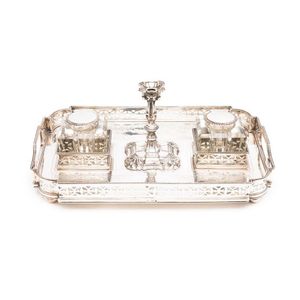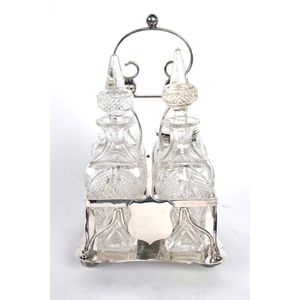Art Deco Diamond Plaque Brooch in White Gold
You must be a subscriber, and be logged in to view price and dealer details.
Subscribe Now to view actual auction price for this item
When you subscribe, you have the option of setting the currency in which to display prices to $Au, $US, $NZ or Stg.
- Rose Cut - A flat based cut for a preious stone, leaving the surface covered with triangular facets, usually 24 in total.
It was introduced in the 15th century and popular during the 16th and 17th centuries.
The rose cut was the most popular form of diamond cut until the discovery of the brilliant cut at the end of the 17th century, after which its use declined. - Art Deco Period - The Art Deco period was a cultural movement that emerged in the 1920s and 1930s, and was characterized by its emphasis on modernism, luxury, and elegance. The name "Art Deco" comes from the Exposition Internationale des Arts Décoratifs et Industriels Modernes, a large exhibition held in Paris in 1925 that showcased the latest trends in decorative arts.
Art Deco was a reaction against the ornate and elaborate styles of the previous era, and reflected a new modern sensibility. It was characterized by streamlined, geometric shapes, bright colours, and the use of new materials such as chrome, glass, and Bakelite. Art Deco designers sought to create a sense of luxury and sophistication, often incorporating expensive materials such as ivory, marble, and rare woods.
Art Deco had a significant impact on a wide range of artistic fields, including architecture, fashion, graphic design, and interior design. Some of the most iconic examples of Art Deco architecture include the Empire State Building in New York City, the Hoover Building in London, and the Palais de Chaillot in Paris.
The Art Deco period came to an end in the 1940s, as World War II and changing cultural trends led to a shift in artistic styles. However, Art Deco remains an important influence on design and art, and continues to be celebrated for its modernist sensibility and glamorous aesthetic. - Millegrain - A type of jewellery setting where the stone is held is held in position by small adjacent beads of metal. This method of securing the stone was popular in the 19th century.
This item has been included into following indexes:
Visually similar items

A Victorian sterling silver rectangular ink stand with two glass inkwells and a taper-stick by Martin Hall & Co Ltd, Sheffield 1879, 28 cm wide, with a collection of various paper knives, pens and pencils

A Chinese blue and white porcelain box and cover, cube shaped raised on four legs modelled as children standing on a square frame base, captured ring handles issue from the side, the lid surmounted by a temple dog, six-character mark under the base. Height

19th century cruet set, four bottle (complete), in EPNS stand, height 25 cm

The Beatles: Irish linen tea towel by Ulster in unused condition; together with 'The Only Authentic Beatle Wig' by Lowell Toy Mfg. Corp. with 1983 re-issue header card.
